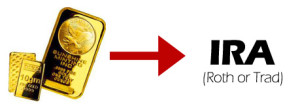- GOLD IRA
- Download Our 2024 Precious Metals IRA Investor’s Guide.
Click Here  Gold IRA
Gold IRA
 Investing
Investing
-
- CRYPTO IRA
- PRICES & STATS
- RETIREMENT PLANS
- BLOG
 Questions? Call (888) 820 1042
Questions? Call (888) 820 1042
How to take a Gold Bullion Distribution from Your IRA
Disclosure: Our content does not constitute financial advice. Speak to your financial advisor. We may earn money from companies reviewed. Learn more
Last Updated on: 26th January 2015, 04:50 pm
Placing physical bullion into a tax-advantaged retirement vehicle, like a self-directed gold IRA, can be a powerful option for many retirement savers. After all, one thing we’ve learned over the past 10 years is that the United States government can jeopardize its own currency — skeptical investors need a place to store value that isn’t denominated in fiat paper.
You can no doubt find plenty of information on the ‘web’ about how and where to buy gold and silver bars / coins. There are plenty of bullion options — see our breakdown of each gold, silver, platinum, and palladium piece allowed in a precious metals IRA — and it’s important to find out which metals are best suited to your interests and needs.
It won’t even take too much searching to learn how to establish a self-directed IRA. We recommend performing a direct transfer or rollover using funds from an existing tax-advantaged retirement account. You can learn more about different types of retirement accounts and rollover procedures here.
The Internal Revenue Service won’t let you hold onto your physical metal while it’s in the IRA, though. So you’ll need to understand safe bullion storage and the difference between allocated and unallocated depositories.
Perhaps the least discussed part about a precious metal IRA, however, is figuring out when, why and how you would need to liquidate your bullion holdings. There are different ways of taking out and using the value of your metal investments, and there are different tax consequences depending on the type of account that you have.
Taking Distributions from a Gold IRA
Let’s say that you have bought some gold and have properly established an IRA and selected a depository. If the value of your gold investment rises, any taxable gain is deferred due to IRA rules. However, you can’t gain access to your gold (or its cash value) without taking a distribution from the IRA itself.
Why would you need to liquidate your gold position in the account and take a distribution? It could be that you need the money to help pay for unexpected expenses. You might also just be taking income during retirement and, this time, it makes the most sense to use some of the bullion to derive that income from.
Distributions from a self-directed IRA can be cash or non-cash; that means that you can either have the actual bullion shipped to you after a distribution (the IRS calls this an “in-kind” distribution) or that you can have the depository “purchase” the metal and give you the dollar-amount value of your holdings. This is a major advantage, allowing you to choose the option that is most appropriate given your preferences or financial needs.
Be careful, though. Any non-exempt distribution that is taken prior to reaching age 59.5 will be accompanied with a 10% tax penalty for early withdrawal.
If you established a Traditional IRA, then any distribution is going to be subject to taxation based on your personal income. This means that you have to take out sufficient gold to pay for the taxes as well (although you could elect to pay the tax out of a cash account). Traditional IRAs also have Required Minimum Distributions (RMDs) beginning at age 70.5, so you may eventually be forced to liquidate your holdings whether you want to or not.
Roth IRA’s do not have RMDs. And, since Roth contributions are made post-tax, the distribution itself is not subject to income taxes. You won’t have to worry about liquidating more gold than you want to in order to pay the IRS.
Before taking a distribution, it’s highly advisable to consult a tax professional or trusted financial advisor to help you with the process. Once you feel that you are ready to begin, you’ll have to submit a distribution request form to your gold depository. You’ll elect which of your bullion bars or coins to take as a distribution, and whether or not you want to have them liquidated into cash.
When you file your taxes, the distribution must be reported accurately to avoid any penalties. If you elect to receive the gold bullion rather than cash, you can continue to hold it as an investment moving forward — but understand that your gains will no longer occur tax-deferred once they are outside of the IRA.




 Silver
Silver Gold
Gold Platinum
Platinum Palladium
Palladium Bitcoin
Bitcoin Ethereum
Ethereum


 Gold: $2,387.15
Gold: $2,387.15
 Silver: $27.92
Silver: $27.92
 Platinum: $931.02
Platinum: $931.02
 Palladium: $903.43
Palladium: $903.43
 Bitcoin: $67,910.26
Bitcoin: $67,910.26
 Ethereum: $3,278.81
Ethereum: $3,278.81
Need help in distributed my Gold Traditional IRA account